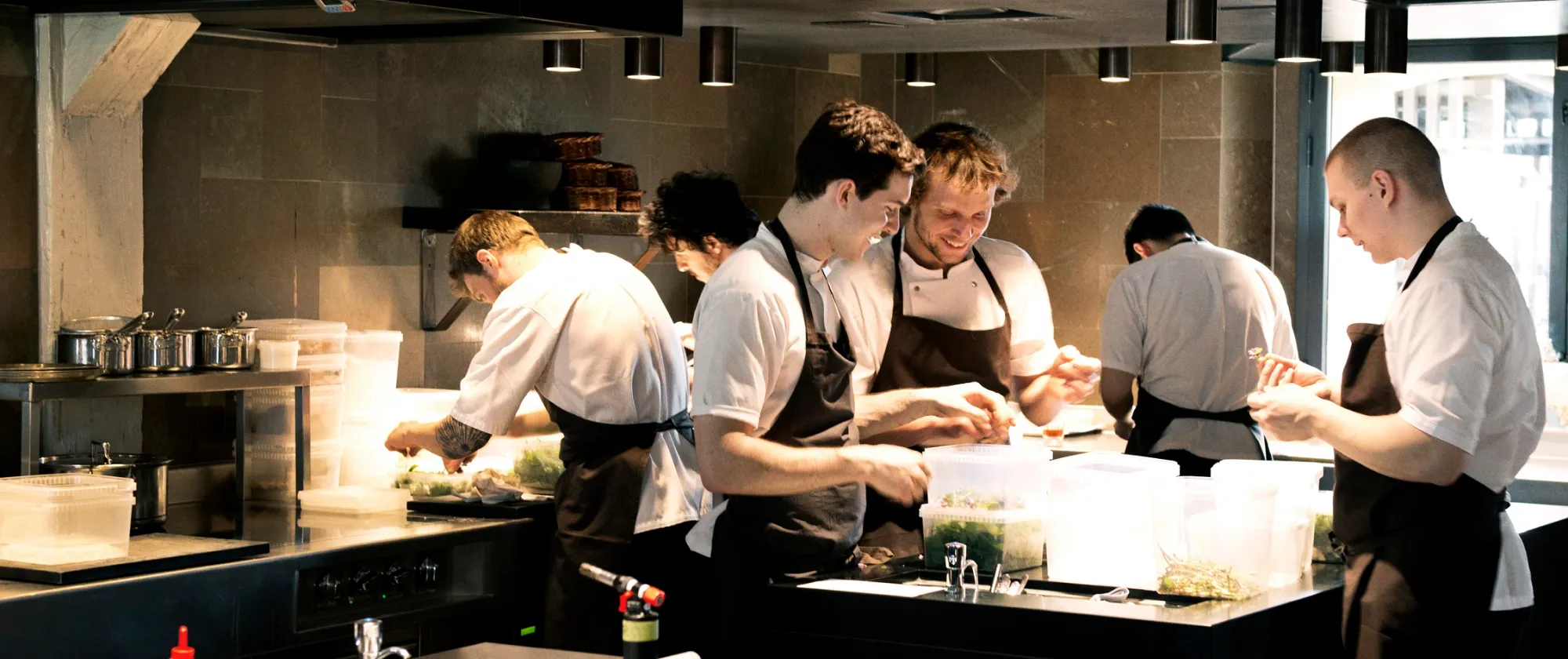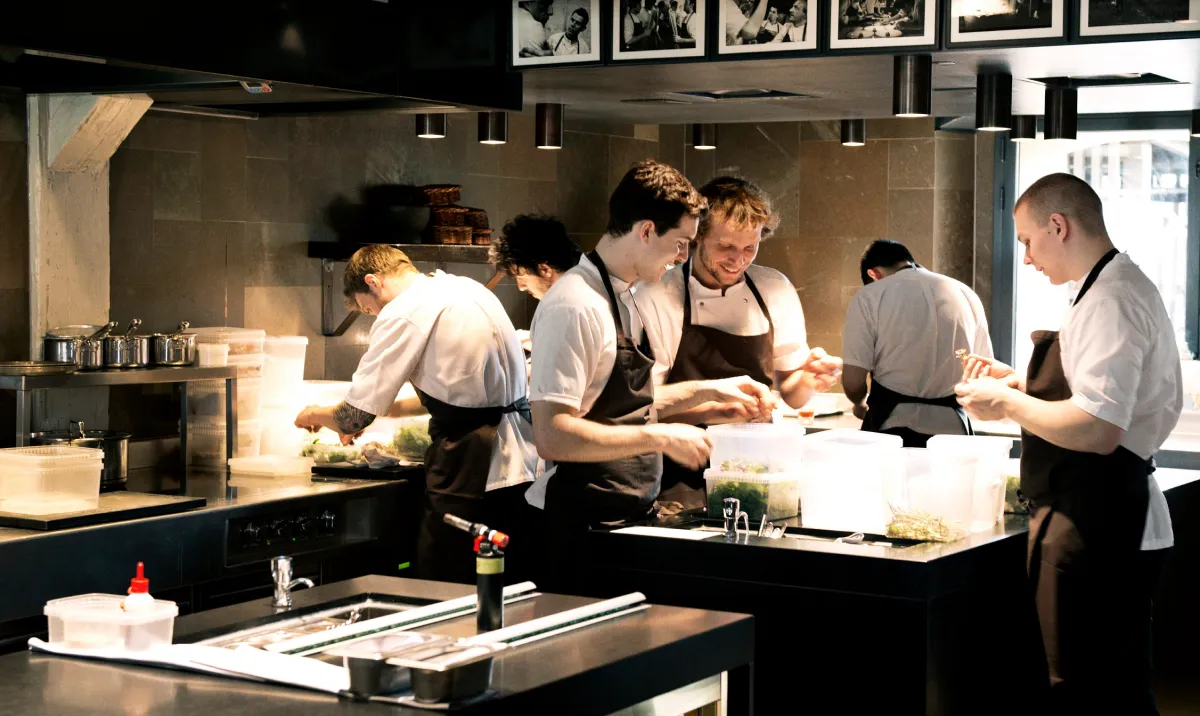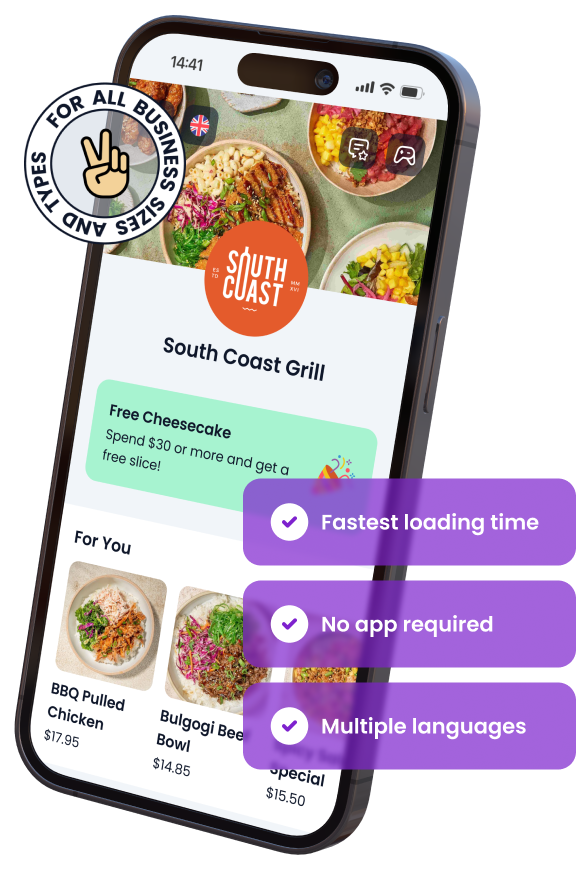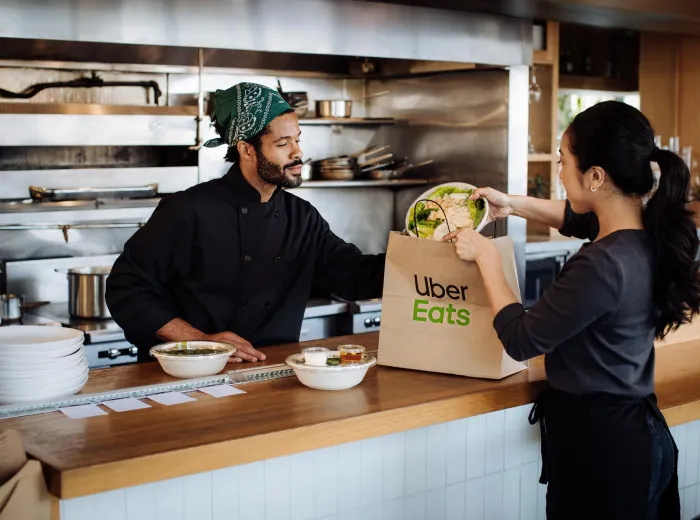

All Restaurant Terms, Slang and Lingo | The Ultimate Guide
Whether you’re a restaurant owner, a manager, or a newcomer to the hospitality industry, understanding restaurant lingo is essential. The fast-paced nature of the business requires clear and efficient communication between staff, which is why kitchens, bars, and dining rooms have developed their own unique vocabulary. From shouting “86” when an item runs out to calling a table a “two-top,” these terms help streamline operations and improve service.
Restaurant slang is more than just insider jargon—it shapes the culture of the industry. A well-versed team can work faster, prevent mistakes, and foster camaraderie. But for those unfamiliar, it can feel like learning a foreign language. That’s where this guide comes in.
In this ultimate glossary, we’ll break down common terms used in restaurants, bars, and kitchens. You’ll discover:
- Essential Front of House (FoH) and Back of House (BoH) terms
- Bartender and kitchen-specific slang
- Business and management phrases used in restaurant operations
- Modern restaurant lingo influenced by technology and online reviews
By the end of this guide, you’ll be fluent in restaurant speak, making it easier to train staff, improve teamwork, and run a smoother operation. Now, let’s dive into the world of restaurant terminology!
What Are Restaurant Terms and Why Do They Matter?
The restaurant industry operates at a fast pace, requiring quick and efficient communication between team members. To keep things running smoothly, restaurants have developed their own specialized language—terms, slang, and abbreviations that streamline communication. Whether it’s a chef calling out “fire” to start cooking a dish or a server saying “86” when an item is unavailable, these terms improve efficiency and reduce misunderstandings.
Understanding restaurant lingo is essential for:
- New hires – Helps them adapt faster to the work environment.
- Managers and owners – Enables clear communication with staff.
- Front of House (FoH) and Back of House (BoH) teams – Improves coordination during service.
- Customers – Some terms, like “prix fixe” or “sommelier,” can enhance the dining experience.
Now, let’s explore why this unique language is crucial for the restaurant industry.
The Language of the Hospitality Industry
Every industry has its own jargon, and restaurants are no exception. Restaurant lingo is a mix of:
- French culinary terms (e.g., mise en place, sous vide)
- Abbreviations (e.g., “POS” for point of sale, “BoH” for back of house)
- Industry-specific slang (e.g., “deuce” for a two-person table)
This specialized vocabulary helps professionals communicate faster, ensuring orders are executed smoothly and efficiently. Without it, service would be slow, mistakes would increase, and the overall dining experience could suffer.
How Understanding Restaurant Lingo Helps Staff and Owners
Knowing common restaurant terms benefits everyone in the business:
- Faster service – Staff can quickly relay information without confusion.
- Stronger teamwork – A shared language fosters better coordination.
- Improved training – New employees learn procedures faster.
- Better problem-solving – Staff can quickly identify and address issues (e.g., calling “86” on a menu item prevents taking unavailable orders).
For owners and managers, fluency in restaurant jargon is key to overseeing operations, coaching employees, and maintaining service efficiency. It also builds credibility with staff, making leadership more effective.
Common Misunderstandings in Restaurant Jargon
Some restaurant terms can be confusing, especially for newcomers. Here are a few commonly misunderstood terms:
- “86” – Often mistaken for an order number, but it means an item is unavailable.
- “On the fly” – Sounds like a cooking method but actually means a dish needs to be made immediately.
- “Covers” – Refers to the number of customers served, not dishware.
- “Fire it” – Doesn’t mean to set something on fire; it’s an instruction to start cooking an order.
Misunderstandings can lead to mistakes, slower service, and frustration among staff. Ensuring everyone is familiar with these terms can help prevent errors and keep operations running smoothly.
Now that we’ve covered the importance of restaurant terminology, let’s dive into the essential terms every restaurant professional should know.
General Restaurant Terms Every Owner and Staff Should Know
The restaurant industry is full of specialized terminology that helps streamline communication and ensure smooth operations. Whether you’re a new hire, a seasoned server, or a restaurant owner, knowing these general terms will improve efficiency and reduce confusion.
These terms are used daily in both Front of House (FoH) and Back of House (BoH) operations. From seating and service phrases to inventory and financial terminology, let’s break down the most important ones.
Front of House (FoH) vs. Back of House (BoH)
The restaurant is divided into two main areas, each with its own responsibilities:
- Front of House (FoH) – Everything that customers see and experience, including:
- The dining area
- Host stand and waiting area
- Bar and lounge
- Servers and customer interactions
- Back of House (BoH) – The behind-the-scenes operations, including:
- The kitchen and food prep areas
- Dishwashing stations
- Storage and inventory management
- Chef, line cooks, and kitchen staff
Understanding this distinction is crucial for clear communication between service staff and kitchen teams.
Walk-In, Turnover, and Covers Explained
Certain restaurant terms are used frequently when managing seating, guest flow, and service efficiency:
- Walk-In – A guest who arrives without a reservation.
- Turnover – The number of times a table is used during a shift. A high turnover rate means more guests are served, increasing revenue.
- Covers – The number of guests served in a shift. Example: “We did 150 covers last night” means 150 guests were served.
- Two-Top, Four-Top, etc. – Refers to table sizes. A two-top is a table for two, a four-top seats four, and so on.
Monitoring turnover and covers helps restaurant owners optimize service speed and maximize profits.
FIFO (First In, First Out) and Other Food Safety Terms
Managing food inventory efficiently ensures quality, reduces waste, and maintains food safety. Here are key terms used in inventory and storage:
- FIFO (First In, First Out) – A stock rotation system where older ingredients are used before newer ones to prevent spoilage.
- Par Level – The minimum quantity of an ingredient or product that must be kept in stock to avoid running out.
- Dead Stock – Inventory that hasn’t been used for a long time and is at risk of expiring.
- 86’d – A term used when an item is no longer available. Example: “The salmon is 86’d” means it’s out of stock.
- Temp Danger Zone – The temperature range (40°F–140°F or 4°C–60°C) where bacteria grow rapidly, making food unsafe to consume.
By following proper food safety protocols like FIFO and monitoring inventory levels, restaurants can reduce waste and ensure compliance with health regulations.
Mastering these general restaurant terms will help owners, managers, and staff run a more efficient and organized business. Now, let’s dive deeper into the lingo used in Front of House (FoH) operations.
Front of House (FoH) Slang and Terms
The Front of House (FoH) is where guests interact with staff, and smooth communication is essential for delivering excellent service. Servers, hosts, bartenders, and managers use a variety of shorthand phrases and slang to keep things moving efficiently.
Understanding these terms ensures that staff can work together seamlessly, minimize errors, and enhance the guest experience. Let’s break down some of the most commonly used FoH phrases.
Host Stand Lingo: "In the Weeds" and "Walk-In"
The host stand is the first point of contact for guests, and hosts use specific terms to manage seating efficiently:
- In the Weeds – When a server or section is overwhelmed with too many tables and orders. Example: “Table 12 just ordered drinks, and 14 needs refills. I’m in the weeds!”
- Walk-In – A guest who arrives without a reservation.
- Waitlist – A list of guests waiting for a table during busy hours.
- No-Show – A reservation that doesn’t arrive, leading to lost revenue.
- Double-Seat – Seating two tables in a server’s section at the same time, which can overwhelm them.
Hosts play a key role in balancing the flow of guests to ensure smooth service.
Server Speak: "Two-Top," "Campers," and "Upselling"
Servers communicate constantly with each other, the kitchen, and bartenders. Their shorthand makes service faster and more efficient:
- Two-Top, Four-Top, etc. – Refers to the number of guests at a table (e.g., “I have a four-top in my section”).
- Campers – Guests who stay at their table long after finishing their meal, reducing turnover.
- Upselling – Encouraging guests to order higher-priced items (e.g., “Would you like to add shrimp to your pasta?”).
- Sidework – Tasks assigned to servers outside of taking orders, like rolling silverware or cleaning sections.
- Comp – When a meal or drink is given for free, usually due to a service issue or VIP treatment.
- Refire – When a dish needs to be remade due to a mistake or customer request.
Using these terms keeps service flowing and helps servers maximize their tips by enhancing guest experiences.
Bartender Jargon: "Neat," "On the Rocks," and "86’d"
Bartenders use their own set of terms when preparing and serving drinks:
- Neat – A drink served without ice, usually in a small glass.
- On the Rocks – A drink served over ice.
- Well Drink – A basic mixed drink made with the bar’s cheapest liquor (e.g., “vodka soda from the well”).
- Call Drink – A drink made with a specific brand of liquor (e.g., “Jack and Coke” instead of just “whiskey and Coke”).
- 86’d – When a drink or ingredient is out of stock (e.g., “We’re 86’d on margarita mix”).
- Last Call – The final opportunity for guests to order drinks before the bar closes.
Knowing bartender jargon helps servers relay drink orders quickly and accurately.
Cashiering and Payment Terms: "Comp," "Void," and "Split Check"
Handling guest payments efficiently requires using specific terms to avoid confusion:
- Comp – Removing an item from a bill, usually for customer service reasons.
- Void – Cancelling an order before it’s prepared, often to correct mistakes.
- Split Check – Dividing a bill between multiple guests. Example: “They want to split the check four ways.”
- Auto-Grat – Automatic gratuity added to large parties, usually 18-20%.
- Tip Pooling – When tips are shared among staff instead of going directly to the server.
Proper use of these terms ensures accuracy in billing and a smooth payment process for guests.
Mastering Front of House (FoH) slang helps restaurant owners, managers, and staff maintain a fast, organized, and customer-friendly service environment. Now, let’s move into the Back of House (BoH) kitchen terms used by chefs and kitchen staff.
Back of House (BoH) Kitchen Terms
The Back of House (BoH) is where the magic happens—chefs, cooks, and kitchen staff work behind the scenes to prepare and plate meals efficiently. A kitchen operates like a well-oiled machine, and quick, precise communication is essential to avoid mistakes and delays.
To keep up with the fast pace, kitchen staff use a specialized vocabulary that every restaurant owner, chef, and cook should know. Let’s explore the most important BoH kitchen terms.
Kitchen Positions: "Sous Chef," "Line Cook," and "Expediter"
A well-structured kitchen has multiple roles, each with specific responsibilities. Here are key kitchen job titles:
- Executive Chef (Chef de Cuisine) – The head of the kitchen, responsible for menu creation, cost control, and staff management.
- Sous Chef – The second-in-command who oversees daily operations and ensures smooth service.
- Line Cook – A cook assigned to a specific station, such as grill, sauté, or fry.
- Expediter (Expo) – The person responsible for managing the food pass, ensuring correct plating, and coordinating between cooks and servers.
- Prep Cook – The staff member who preps ingredients before service (e.g., chopping vegetables, marinating meats).
- Dishwasher (Porter) – The person responsible for cleaning dishes and kitchen tools, often an unsung hero of the restaurant.
Each role is essential for maintaining efficiency and delivering high-quality food to guests.
Cooking Methods and Shortcuts: "Sauté," "Blanch," and "Mise en Place"
Kitchens rely on quick commands to describe cooking techniques. Some of the most common ones include:
- Mise en Place – A French term meaning “everything in its place.” It refers to prepping ingredients before service.
- Sauté – Cooking food quickly in a small amount of fat over high heat.
- Blanch – Briefly boiling food, then cooling it in ice water to preserve texture and color.
- Deglaze – Using liquid (like wine or broth) to lift caramelized bits from a pan for added flavor.
- Baste – Continuously spooning liquid over food to keep it moist (often used for roasting meats).
- Flash-Fry – Cooking food quickly at high temperatures to create a crispy texture.
Knowing these terms helps kitchen staff execute orders quickly and consistently.
Ticket and Ordering Terms: "Fire It," "All Day," and "Hold"
A kitchen runs on speed, and communication between servers and cooks must be instant. Here are essential order-related terms:
- Fire It – Start cooking a dish immediately. Example: “Fire table 12’s entrées!”
- All Day – The total count of a specific item that needs to be cooked. Example: “We have 10 steaks all day.”
- Hold – Delay an order until further notice. Example: “Hold table 6’s appetizer.”
- Drag It – A dish that’s taking longer than expected. Example: “That pasta is dragging!”
- Sell It – A dish that’s ready to be taken to the dining area. Example: “Burger up! Sell it!”
These terms keep the flow of orders moving smoothly and reduce confusion in the kitchen.
Inventory and Storage Slang: "Dead Stock," "Par Level," and "FIFO"
Managing inventory correctly prevents food waste and ensures fresh ingredients are always available. Here are key storage terms:
- FIFO (First In, First Out) – A method of using older ingredients before newer ones to prevent spoilage.
- Par Level – The minimum amount of stock required to operate without running out.
- Dead Stock – Ingredients that haven’t been used in a long time and are at risk of going bad.
- 86’d – An item that is out of stock. Example: “We’re 86’d on salmon.”
- Lowboy – A small under-counter refrigerator used for easy access to frequently used ingredients.
A well-organized kitchen reduces waste, ensures efficiency, and maintains food quality.
Mastering Back of House (BoH) kitchen terms helps restaurant owners, managers, and kitchen staff run a smoother, more effective operation. Next, let’s explore the service industry codes and etiquette that every restaurant professional should know.
Service Industry Codes and Etiquette
The restaurant industry is fast-paced, and staff must communicate efficiently to keep operations running smoothly. While kitchen lingo and front-of-house (FoH) slang are essential, non-verbal cues, service codes, and etiquette rules play a crucial role in ensuring seamless coordination among employees.
Knowing these service industry codes helps staff avoid collisions, maintain professionalism, and deliver an excellent guest experience. Let’s explore the essential communication methods and etiquette practices used in restaurants.
Non-Verbal Cues Between Staff: "Corner," "Behind," and "Sharp"
In a busy restaurant, yelling every instruction isn’t practical. Instead, non-verbal cues and short phrases help employees navigate safely and efficiently:
- Corner! – Shouted when turning a blind corner to avoid collisions.
- Behind! – A warning that someone is walking behind another person, preventing accidental bumps or spills.
- Sharp! – A caution that someone is carrying a sharp knife or blade.
- Hot! – A warning that a hot plate or pan is being carried through the kitchen or dining area.
- Hands! – Used when food is ready to be run to a table and a server is needed to take it.
These quick alerts prevent accidents and keep the workflow smooth, especially during busy shifts.
How Staff Communicate During Rush Hours
Rush hours can be chaotic, and clear, concise communication is critical for a restaurant’s success. Here are key terms and best practices:
- “In the weeds” – A term used when a staff member is overwhelmed with too many tasks or tables. Example: “Can someone help? I’m in the weeds!”
- “On the fly” – An urgent request for an order to be prepared as quickly as possible.
- “Double-seat” – When two tables are seated in the same section at the same time, making it more challenging for the server.
- “Check back, check down” – A service rule where a server returns to check on a guest within a few minutes after food arrives and drops the check promptly when guests finish their meal.
A well-trained team understands how to balance speed and attentiveness to maximize both efficiency and guest satisfaction.
Secret Language Between Servers and Bartenders
Bartenders and servers have their own short-hand lingo to streamline drink service:
- “One for the well” – A generic order for the cheapest house liquor.
- “Tall” vs. “Short” – Indicates drink size (e.g., “Jack and Coke, tall” means extra mixer).
- “Muddle” – A request to crush ingredients like fruit or herbs for a cocktail.
- “Float” – A small amount of liquor added to the top of a drink without mixing.
- “Last call” – The final opportunity for guests to order drinks before closing.
Clear communication between servers and bartenders reduces order mistakes, speeds up service, and keeps customers happy.
Mastering service industry codes and etiquette makes restaurant operations smoother, safer, and more efficient. Now, let’s explore common bar and cocktail terminology used by bartenders and mixologists.
Common Bar and Cocktail Terminology
The bar is a key part of many restaurants, and bartenders, servers, and mixologists use a unique set of terms to ensure fast and accurate drink service. Whether it’s a simple whiskey “neat” or a cocktail with a “float,” understanding bar lingo helps improve efficiency and customer satisfaction.
Knowing these common bar and cocktail terms will ensure that restaurant owners, managers, and staff can communicate seamlessly while offering a top-tier guest experience.
Drink Orders: "Straight Up," "Dirty," and "With a Twist"
When ordering drinks, customers and bartenders use specific terminology to describe how they want their beverages prepared. Here are some of the most common terms:
- Neat – A drink served without ice, mixers, or chilling, typically in a rocks glass. Example: “I’ll have a bourbon neat.”
- On the Rocks – A drink served over ice. Example: “Whiskey on the rocks, please.”
- Straight Up – A drink that is shaken or stirred with ice, then strained into a glass without ice.
- Dirty – A cocktail (typically a martini) made with olive brine for a salty, tangy flavor.
- With a Twist – A drink served with a citrus peel garnish, usually lemon or lime.
- Dry vs. Wet – A “dry” drink (e.g., a dry martini) contains less vermouth, while a “wet” drink contains more.
Bartenders and servers must understand these terms to ensure customers receive their drinks exactly as they expect.
Liquor Measurements: "Shot," "Jigger," and "Pony"
Bars use standardized measurements to ensure consistency in cocktail recipes and liquor pours. Here are key bar measurement terms:
- Shot – A single serving of liquor, usually 1.5 ounces (44 ml) in the U.S.
- Jigger – A measuring tool with two sides; the standard jigger holds 1.5 oz on one side and 0.75 oz on the other.
- Pony – A smaller shot measuring 1 ounce (30 ml).
- Double – A drink made with twice the standard liquor amount (e.g., a double vodka soda).
- Float – A small amount of liquor or syrup poured on top of a drink without stirring it in.
Understanding measurements helps bartenders maintain consistency and prevent over-pouring, which can impact profit margins.
Cocktail Prep Terms: "Shake," "Stir," and "Muddle"
Bartenders use different techniques to mix drinks and enhance their flavors. Here are key cocktail preparation terms:
- Shake – Mixing ingredients in a cocktail shaker with ice to chill and blend flavors quickly.
- Stir – Gently mixing a drink (often using a long spoon) to preserve clarity and texture.
- Muddle – Crushing herbs, fruits, or sugar with a muddler to release their flavors (e.g., mojitos and old-fashioneds).
- Layer – Pouring ingredients carefully so they create distinct layers instead of mixing.
- Build – Making a cocktail directly in the serving glass, instead of using a shaker.
These preparation methods influence the final taste, texture, and presentation of cocktails.
Customer Lingo: "Regular," "Barfly," and "Last Call"
Customers also have their own lingo when ordering drinks or interacting at the bar. Here are common terms used in bar culture:
- Regular – A frequent customer who visits often and is known by the staff.
- Barfly – A customer who spends excessive time at the bar, often drinking alone.
- Last Call – The final opportunity for customers to order drinks before the bar closes.
- Tabs Open/Closed – Keeping a tab open means the customer keeps ordering and pays at the end, while a closed tab is paid immediately.
- Well vs. Call Drink – A well drink uses the bar’s cheapest liquor, while a call drink specifies a brand (e.g., “Jack and Coke” instead of just “whiskey and Coke”).
These terms help bartenders and servers manage customer expectations and maintain an efficient bar service.
Mastering bar and cocktail terminology ensures faster service, improves drink consistency, and enhances guest satisfaction. Next, let’s explore restaurant management and business terms that every owner should know.
Restaurant Management and Business Terms
Running a successful restaurant isn’t just about great food and service—it also requires a strong grasp of financials, operations, and marketing. Restaurant owners, managers, and investors use specific industry terms to measure profitability, control costs, and optimize efficiency.
Understanding these key management and business terms will help restaurant professionals increase revenue, reduce waste, and improve decision-making. Let’s break them down.
Revenue and Profitability Terms: "Food Cost," "Labor Cost," and "Prime Cost"
A restaurant’s success depends on its ability to control expenses and maximize profits. Here are essential financial terms:
- Food Cost – The total cost of ingredients for menu items, usually expressed as a percentage of sales. Example: If a burger costs $3 to make and sells for $12, the food cost percentage is 25%.
- Labor Cost – The percentage of revenue spent on wages, salaries, and payroll taxes. A well-managed restaurant keeps labor costs under 30% of total sales.
- Prime Cost – The total of food and labor costs, which should stay below 60-65% of total revenue.
- Gross Profit Margin – The percentage of revenue remaining after food and beverage costs but before labor and other expenses.
- Net Profit Margin – The final profit percentage after all operating expenses, taxes, and overhead are deducted.
Keeping a close eye on these metrics helps restaurant owners improve profitability and reduce unnecessary expenses.
Operational Lingo: "Pacing," "Double Seating," and "Push the Specials"
Efficient restaurant operations require smart scheduling, smooth table flow, and proper order pacing. Here are terms used in daily operations:
- Pacing – Controlling the timing of orders to prevent the kitchen from becoming overwhelmed. Example: “Let’s pace the entrées so they don’t all fire at once.”
- Double Seating – Seating two parties in the same section at once, which can overwhelm a server.
- Push the Specials – Encouraging servers to promote high-margin or limited-time menu items.
- Pre-Shift Meeting – A daily briefing for staff covering specials, VIP guests, and service goals.
- Sidework – Extra tasks for servers, such as rolling silverware, refilling condiments, and cleaning tables.
These terms ensure a well-organized shift, smooth guest experience, and better revenue optimization.
Hiring and HR Terminology: "Stages," "No Call No Show," and "Cross-Training"
Hiring and retaining restaurant staff can be challenging. Here are key terms used in HR and employee management:
- Stages (Stahj) – A trial shift for new hires (often unpaid in fine dining) to assess skills.
- No Call No Show – When an employee fails to show up for a shift without calling in, often leading to termination.
- Cross-Training – Training employees for multiple roles (e.g., teaching a server how to bartend).
- Tip Pooling – A system where all tips are shared among servers, bussers, and kitchen staff.
- FOH vs. BOH Pay Structure – FOH (Front of House) staff often earn lower wages but receive tips, while BOH (Back of House) staff earn higher base wages with no tips.
Understanding HR terminology helps restaurant owners build strong teams, prevent turnover, and improve employee satisfaction.
Marketing and Promotions: "Soft Launch," "Prix Fixe," and "Loyalty Program"
Marketing is essential for attracting new customers and retaining repeat diners. Here are common marketing terms:
- Soft Launch – A restaurant’s unofficial opening to test service and menu before the grand opening.
- Prix Fixe (Pre-Fixed) – A set menu at a fixed price, common in fine dining and special events.
- Loyalty Program – A rewards system that encourages repeat visits by offering discounts or perks.
- Guest Experience Management (GEM) – The process of gathering feedback and responding to online reviews to maintain a positive reputation.
- SEO for Restaurants – Optimizing the restaurant’s website and online presence to appear higher in search results (e.g., “Best Italian restaurant near me”).
A strong marketing strategy helps increase foot traffic, boost brand recognition, and drive repeat business.
Mastering restaurant management and business terms will help owners and managers improve operations, boost profitability, and build a thriving restaurant. Next, let’s explore customer interaction and feedback terms that impact guest satisfaction.
Customer Interaction and Feedback Terms
Providing excellent customer service is essential for any restaurant’s success. The way staff communicate with guests, handle complaints, and respond to feedback plays a crucial role in shaping the dining experience. Understanding these customer interaction and feedback terms will help restaurant owners, managers, and staff maintain a high level of service and build a strong reputation.
Customer Complaints: "Service Recovery," "Comping," and "Guest Recovery"
Even the best restaurants occasionally face customer complaints. Handling them professionally can turn a bad experience into a positive one. Here are key terms used in customer complaint management:
- Service Recovery – The process of fixing a mistake or issue quickly and efficiently to regain customer trust.
- Comping – Offering a free dish, drink, or discount as a goodwill gesture for an unhappy guest. Example: “The steak was overcooked, so we comped the entrée.”
- Guest Recovery – A proactive approach to resolving a complaint before the guest leaves unhappy. Example: “A server noticed the guest wasn’t happy with their meal and replaced it immediately.”
- Remake vs. Refire – A remake is when a dish is completely redone, while a refire means a dish is quickly prepared again due to an issue.
- Check Back, Check Down – A strategy where servers check on guests after food arrives and discreetly leave the check when diners are finishing up.
Handling complaints well can turn a frustrated guest into a loyal customer and protect the restaurant’s reputation.
Positive Feedback Phrases: "VIP Treatment," "Word of Mouth," and "Five-Star Experience"
Encouraging and recognizing positive guest experiences is just as important as handling complaints. Here are terms related to guest satisfaction and promotions:
- VIP Treatment – Offering special attention or perks to valued guests, regulars, or influencers. Example: “Let’s send a complimentary dessert to our VIP table.”
- Word of Mouth – The power of guests recommending a restaurant to friends and family, one of the best forms of marketing.
- Five-Star Experience – Delivering exceptional service and food that earns high ratings on review sites.
- Secret Shopper – A person hired to visit the restaurant anonymously and evaluate service quality.
- Guest Engagement – Building relationships with diners through personalized service and interactions. Example: “The manager stopped by the table to engage with the guests.”
Encouraging positive feedback helps restaurants attract new guests and retain loyal customers.
Common Online Review Terms: "Yelp Elite," "Google My Business," and "SEO for Restaurants"
With online reviews influencing where people choose to dine, restaurants must actively manage their digital presence. Here are key terms in online review management:
- Yelp Elite – A select group of Yelp users known for detailed and influential reviews.
- Google My Business (GMB) – A free tool that lets restaurants manage their online presence, including location, hours, and customer reviews.
- SEO for Restaurants – Strategies to optimize a restaurant’s website and online profiles so it ranks higher in search results. Example: “Optimizing our menu descriptions for SEO increased online orders.”
- Review Bombing – When multiple people leave negative reviews in an attempt to damage a restaurant’s reputation.
- Reputation Management – The process of responding to reviews, managing feedback, and maintaining a positive online image.
A strong online presence and positive reviews can significantly impact a restaurant’s success, attracting more customers and boosting sales.
Mastering customer interaction and feedback terms helps restaurants provide excellent service, handle complaints effectively, and maintain a strong reputation. Next, let’s explore industry slang and regional variations in restaurant terminology.
Industry Slang and Regional Variations
Restaurant slang varies across different types of dining establishments, locations, and cultures. While many terms are universally recognized in the industry, fast food, fine dining, and casual eateries all have their own unique jargon. Additionally, regional and international differences in terminology can create variations in how restaurant professionals communicate.
Understanding these slang terms and regional variations can help restaurant owners and staff communicate effectively, no matter where they work.
Fast Food and QSR (Quick Service Restaurant) Lingo
Fast food and quick service restaurants (QSRs) have their own set of terms to describe speed, orders, and customer interactions:
- Drive-Thru Time – The total time a customer spends from ordering to receiving their food. Keeping this low is a key performance metric.
- Rush – A sudden influx of customers, often during peak hours like lunch or dinner.
- DTL (Drive-Thru Line) – The number of cars waiting to order at a drive-thru.
- Expediter (Expo) – The person who ensures orders are properly assembled and handed to customers quickly.
- Drop It – When an employee is instructed to start frying items like fries or nuggets. Example: “Drop a batch of fries!”
- Window Time – The time it takes to hand food to a drive-thru customer once they arrive at the window.
These terms help QSR staff maintain efficiency and optimize speed to serve customers quickly.
Fine Dining vs. Casual Dining Terms
Fine dining establishments use formal service terminology, while casual dining restaurants often rely on more relaxed language. Here’s a comparison:
| Fine Dining Term | Casual Dining Equivalent | Meaning |
|---|---|---|
| Amuse-Bouche | Complimentary Starter | A small appetizer given before the meal. |
| Front Waiter | Lead Server | The main server for a table in a fine dining setting. |
| Back Waiter | Busser | The person responsible for clearing dishes and assisting the lead server. |
| Service à la Russe | Courses Served Individually | Serving dishes in sequential courses, common in upscale restaurants. |
| Crumbing the Table | Clearing Crumbs | Using a tool to clean crumbs off the table between courses. |
| Sommelier | Wine Expert | A trained wine professional who helps with wine selections. |
Fine dining places emphasize formal language and etiquette, while casual restaurants use simpler, fast-paced terminology for efficiency.
Regional and Cultural Differences in Restaurant Jargon
Restaurant slang varies by country and region, leading to differences in terminology across locations:
- United States vs. United Kingdom
- “Check” (US) vs. “Bill” (UK) – The receipt given to customers at the end of a meal.
- “To-Go” (US) vs. “Takeaway” (UK) – Food meant to be taken off-premises.
- “Appetizer” (US) vs. “Starter” (UK) – A small dish before the main course.
- France
- “Brigade System” – A structured kitchen hierarchy developed by Auguste Escoffier that defines clear roles in a fine dining kitchen.
- “Degustation Menu” – A multi-course tasting menu common in Michelin-starred restaurants.
- Italy
- “Coperto” – A service charge automatically added to a bill, common in Italian trattorias and ristorantes.
- “Primo, Secondo” – In traditional Italian dining, “primo” refers to the first course (pasta or soup), and “secondo” is the main dish (meat or fish).
- Japan
- “Izakaya” – A casual Japanese bar serving small plates, similar to tapas.
- “Omakase” – A chef’s choice meal, often found in sushi restaurants.
Knowing regional variations in restaurant terms can help owners and staff adapt to different service styles and customer expectations when working in international settings.
Mastering industry slang and regional variations allows restaurant professionals to communicate more effectively and better understand cultural dining differences. Next, let’s explore modern trends and digital-age terminology shaping today’s restaurant industry.
Modern Trends and Digital Age Terminology
The restaurant industry has rapidly evolved with technology, online ordering, and social media, introducing new terms that every restaurant owner and manager should know. From ghost kitchens to food influencers, staying up to date with modern terminology helps restaurants stay competitive in a digital-first world.
Let’s explore the most relevant modern trends and digital-age restaurant terms that impact daily operations, marketing, and customer engagement.
Online Ordering and Delivery Terms: "Ghost Kitchen," "Virtual Brand," and "Aggregator"
With the rise of food delivery apps and online ordering, restaurants must understand the new landscape of digital dining. Here are key terms:
- Ghost Kitchen (Cloud Kitchen) – A delivery-only restaurant with no dine-in service, operating out of a shared or private kitchen space.
- Virtual Brand – A restaurant brand that exists only online, typically operating out of an existing kitchen. Example: A burger brand run from a pizza restaurant’s kitchen for delivery orders only.
- Aggregator – A third-party delivery platform like Uber Eats, DoorDash, or Talabat that connects restaurants with customers.
- POS Integration – Connecting a restaurant’s Point-of-Sale (POS) system with online ordering platforms for seamless order management.
- Third-Party vs. First-Party Delivery – Third-party delivery uses apps like Grubhub, while first-party delivery is run directly by the restaurant.
These terms are essential for restaurants that rely on digital sales and delivery services.
Social Media Slang: "Foodie," "Instagrammable," and "Viral Dish"
Social media plays a huge role in restaurant marketing, influencing where people choose to eat. Here are key social media-related restaurant terms:
- Foodie – A person passionate about trying and reviewing new food experiences, often sharing them on social media.
- Instagrammable – A dish or restaurant interior that is visually appealing and likely to be shared online. Example: “Let’s make our dessert more Instagrammable with a colorful drizzle.”
- Viral Dish – A menu item that gains massive popularity online, often leading to increased demand. Example: The “TikTok Pasta” trend.
- UGC (User-Generated Content) – Social media content created by customers showcasing a restaurant’s food or experience.
- Hashtag Marketing – Using trending hashtags to increase visibility on platforms like Instagram and TikTok.
A strong social media presence boosts brand awareness and attracts new customers.
New-Age Dining Concepts: "Farm-to-Table," "Sustainable Sourcing," and "Plant-Based"
As customer preferences shift toward sustainability and healthier dining options, new food concepts and industry terms have emerged:
- Farm-to-Table – A restaurant concept that prioritizes locally sourced, fresh ingredients directly from farms.
- Sustainable Sourcing – Ensuring food is ethically produced, including responsible seafood sourcing and organic farming.
- Plant-Based vs. Vegan – Plant-based focuses on mostly plant-derived ingredients, while vegan excludes all animal products entirely.
- Flexitarian – A dietary trend where customers eat primarily plant-based meals but occasionally consume meat or fish.
- Zero-Waste Kitchen – A restaurant kitchen that aims to reduce food waste by repurposing ingredients and using sustainable practices.
Restaurants embracing these trends appeal to environmentally conscious and health-focused customers.
Staying updated on modern restaurant trends and digital-age terminology helps businesses adapt to industry changes, improve marketing, and meet customer expectations. Next, let’s explore funny, outdated, and unusual restaurant slang that has shaped industry culture over time.
Funny, Outdated, and Unusual Restaurant Slang
The restaurant industry has developed its own quirky and colorful language over the years. Some of these terms are still used today, while others have faded into history. Many originated in diners, old-school kitchens, and fine dining establishments, reflecting the culture of different eras.
Let’s take a look at some of the funniest, most unusual, and outdated restaurant slang that has shaped the industry.
Old School Terms No One Uses Anymore
Some restaurant slang has fallen out of favor but remains a fun part of industry history. Here are some terms that used to be common but are rarely heard today:
- “Bubble Dancer” – A dishwasher, referring to the bubbles from soap and water.
- “Graveyard Platter” – A dish made from leftovers to prevent food waste.
- “Blue Plate Special” – A daily meal deal popular in diners during the mid-20th century.
- “Mystery in the Alley” – A dish left unclaimed in the kitchen, often given to staff.
- “Customer in the Kitchen” – A sarcastic way to say a dish was sent back for being undercooked.
- “86’d” – Originally from Prohibition-era bars, meaning an item is out of stock or unavailable.
While these terms may be outdated, they still pop up occasionally among old-school restaurant veterans.
Bizarre but True Restaurant Phrases
Some restaurant slang sounds so strange that it seems made up—but these terms are still used today!
- “Burn the Ice” – Pouring hot water over ice in a bin to melt it quickly.
- “Clopen” – When an employee closes the restaurant at night and opens it again the next morning, leading to exhaustion.
- “Campers” – Guests who linger at their table for too long, preventing turnover.
- “S.O.S.” – Short for “Same Old Stuff”, often used to refer to boring or repetitive meals.
- “Dead Plate” – A dish that has sat too long in the window and is no longer fresh enough to serve.
- “Toss a Salad on the Fly” – A last-minute, rushed order for a salad.
These unique expressions are fun reminders of how lively and fast-paced restaurant work can be.
Slang That Has Made It into Pop Culture
Over time, restaurant slang has gone mainstream, appearing in movies, TV shows, and even everyday conversations. Here are some well-known phrases that originated in the industry:
- “86’d” – Now used beyond restaurants to mean something is canceled or removed.
- “Cup of Joe” – A nickname for coffee, originating from American diners.
- “Easy on the Ice” – A bar term that is now commonly used at coffee shops and fast-food restaurants.
- “Order Up!” – A phrase shouted by chefs when food is ready, often heard in movies and TV shows.
- “Check, Please!” – A universal way to signal the end of a meal, often exaggerated in comedies.
These terms show how restaurant culture has influenced everyday language and continues to shape how we talk about food and service.
Restaurant slang is full of humor, history, and creativity, adding character to the fast-paced world of hospitality. Next, let’s explore how to learn and use restaurant slang effectively to improve teamwork and efficiency in your restaurant.
How to Learn and Use Restaurant Slang Effectively
Mastering restaurant slang isn’t just about sounding like a seasoned industry pro—it’s about improving communication, boosting efficiency, and fostering teamwork. Whether you’re training new staff, running a busy shift, or managing a restaurant, knowing the right terminology can help operations flow smoothly.
Here’s how to learn, teach, and use restaurant slang effectively in a professional setting.
Training New Staff on Industry Lingo
For new hires, restaurant slang can feel like a foreign language. Proper training ensures faster adaptation and fewer mistakes. Here’s how to introduce new employees to industry lingo:
- Use a Training Glossary – Create a list of essential terms for new staff to review. Example: “86 means we’re out of an item.”
- Shadow Experienced Employees – Let new hires observe and listen to real-time communication between staff.
- Role-Playing Exercises – Run practice scenarios to simulate service rushes and use common restaurant phrases. Example: “You’re a server—how would you handle an ‘in the weeds’ situation?”
- Test Knowledge in a Fun Way – Hold quick quizzes or games to help staff memorize important terms.
The goal is to make learning engaging and practical, so employees feel confident using restaurant lingo on the floor.
The Importance of Clear Communication
While slang makes communication more efficient, it should never create confusion. Here’s how to ensure clarity in a fast-paced restaurant environment:
- Avoid Overusing Jargon with Guests – Customers may not understand phrases like “fire it” or “86’d”, so keep communication guest-friendly.
- Use Context When Training – Explain why certain terms are used to help employees remember them better. Example: “‘On the fly’ means the kitchen needs to rush an order.”
- Encourage Questions – Create an environment where new staff feel comfortable asking about unfamiliar terms.
- Standardize Language – Make sure everyone on the team understands the same terms, avoiding miscommunication.
A well-trained team that speaks the same restaurant language can work together seamlessly and avoid mistakes.
Balancing Professionalism with Informal Jargon
Using restaurant slang effectively means knowing when and where to use it. Here’s how to strike the right balance:
- With Staff: Slang is great for speed and efficiency, but it should never replace professional or respectful communication. Example: “Behind!” is useful, but yelling unnecessarily can add stress.
- With Customers: Avoid overly technical or industry-specific phrases. Instead of “comping,” say, “We’ll take care of that for you.”
- In Management: Use a mix of slang and formal language when coaching employees. Example: “Fire that order now” works in the kitchen, but “Expedite that process” might work better in a business meeting.
- In Online and Marketing Content: Some restaurant slang, like “farm-to-table” or “prix fixe,” works well in branding, but too much industry jargon may confuse customers.
The key is to use restaurant slang strategically—making communication smoother without alienating guests or new staff members.
Mastering and using restaurant slang effectively helps improve teamwork, streamline service, and create a strong workplace culture. Whether you’re training new hires or running a busy shift, understanding when and how to use restaurant lingo will make your business more efficient and professional.
Key Takeaways
Understanding restaurant terms, slang, and lingo is essential for smooth communication, efficient service, and a well-run operation. Whether you’re a restaurant owner, manager, or staff member, knowing industry-specific terminology helps you work faster, avoid mistakes, and create a better guest experience.
Here are the key lessons from this guide:
- Restaurant lingo improves efficiency – Terms like “fire it,” “86’d,” and “on the fly” keep kitchens and service teams running smoothly.
- Front of House (FoH) and Back of House (BoH) have distinct vocabularies – Servers, hosts, and bartenders use guest-facing language, while kitchen staff rely on short, direct commands for speed.
- Mastering bar and cocktail terminology enhances service – Knowing terms like “neat,” “muddle,” and “float” ensures accurate drink preparation and prevents confusion.
- Business and financial terms are crucial for profitability – Concepts like food cost, labor cost, and prime cost help restaurant owners maximize revenue.
- Customer interaction and feedback terminology help build a strong reputation – Handling service recovery, comping, and online reviews properly enhances guest satisfaction.
- Industry slang varies by location and restaurant type – Fast food, fine dining, and international restaurants all have unique phrases and customs.
- Modern trends shape new restaurant terminology – Concepts like ghost kitchens, virtual brands, and Instagrammable dishes influence today’s industry.
- Using slang effectively requires balance – While restaurant jargon speeds up communication, it should be used strategically to ensure clarity for staff and guests.
By mastering these essential restaurant terms and industry slang, you’ll be able to communicate like a pro, train your team more effectively, and run a smoother, more profitable operation. Whether you’re managing a fine dining establishment, a fast casual eatery, or a ghost kitchen, understanding the language of the industry gives you a competitive edge! 🚀
ABOUT THE AUTHOR
Erkin Coban
Your Customers Deserve The Best
And we got Menuviel for them.
The fastest and easy-to-use online QR menu with 12+ unique features. Choose Menuviel and elevate your service quality to the next level.
Use free for the first 30 days.

In This Article

Free AI Tools for Restaurants
TRY NOW ➜

Lightning-fast loading pages and images
Your menu loads instantly with optimized images—no waiting, just a smooth browsing experience.





